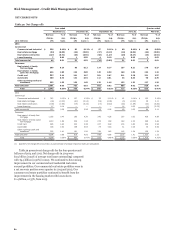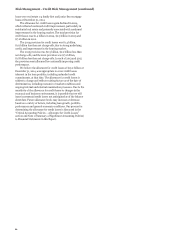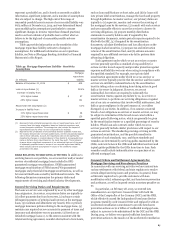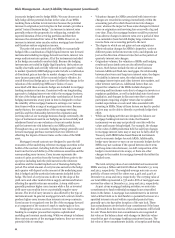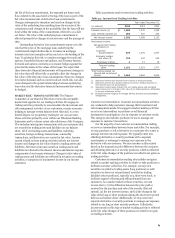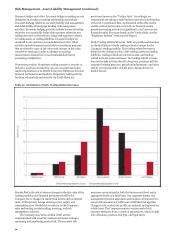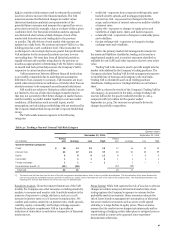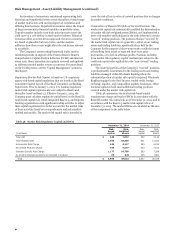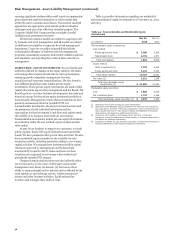Wells Fargo 2014 Annual Report Download - page 89
Download and view the complete annual report
Please find page 89 of the 2014 Wells Fargo annual report below. You can navigate through the pages in the report by either clicking on the pages listed below, or by using the keyword search tool below to find specific information within the annual report.
Table 44: Earnings Sensitivity Over 24 Month Horizon
Relative to Most Likely Earnings Plan
Most Lower rates Higher rates
likely Scenario 1 Scenario 2 Scenario 3 Scenario 4
Ending rates:
Federal funds 1.87 % 0.25 1.61 2.10 5.00
10-year
treasury (1) 3.76 1.70 3.26 4.26 6.01
Earnings relative
to most likely N/A (2)-(3) % (1)-(2) 0 - 5 >5
(1) U.S. Constant Maturity Treasury Rate
We use the investment securities portfolio and exchange-
traded and over-the-counter (OTC) interest rate derivatives to
hedge our interest rate exposures. See the “Balance Sheet
Analysis - Investment Securities” section in this Report for more
information on the use of the available-for-sale and held-to-
maturity securities portfolios. The notional or contractual
amount, credit risk amount and fair value of the derivatives used
to hedge our interest rate risk exposures as of
December 31, 2014, and December 31, 2013, are presented in
Note 16 (Derivatives) to Financial Statements in this Report. We
use derivatives for asset/liability management in two main ways:
• to convert the cash flows from selected asset and/or liability
instruments/portfolios, including investments, commercial
loans and long-term debt, from fixed-rate payments to
floating-rate payments, or vice versa; and
• to economically hedge our mortgage origination pipeline,
funded mortgage loans and MSRs using interest rate swaps,
swaptions, futures, forwards and options.
MORTGAGE BANKING INTEREST RATE AND MARKET RISK
We originate, fund and service mortgage loans, which subjects
us to various risks, including credit, liquidity and interest rate
risks. Based on market conditions and other factors, we reduce
credit and liquidity risks by selling or securitizing some or all of
the long-term fixed-rate mortgage loans we originate and most
of the ARMs we originate. On the other hand, we may hold
originated ARMs and fixed-rate mortgage loans in our loan
portfolio as an investment for our growing base of core deposits.
We determine whether the loans will be held for investment or
held for sale at the time of commitment. We may subsequently
change our intent to hold loans for investment and sell some or
all of our ARMs or fixed-rate mortgages as part of our corporate
asset/liability management. We may also acquire and add to our
securities available for sale a portion of the securities issued at
the time we securitize MHFS.
As expected, with the increase in average mortgage interest
rates in 2014, our mortgage banking revenue declined as the
level of mortgage loan refinance activity decreased compared
with 2013. The decline in mortgage loan origination income
(primarily driven by the decline in mortgage loan refinancing
volume) more than offset the increase in net servicing income.
Despite the increase in average mortgage interest rates, the slow
recovery in the housing sector, and the continued lack of
liquidity in the nonconforming secondary markets, our mortgage
banking revenue was strong in 2014, reflecting the
complementary origination and servicing strengths of the
business. The secondary market for agency-conforming
mortgages functioned well during 2014.
Interest rate and market risk can be substantial in the
mortgage business. Changes in interest rates may potentially
reduce total origination and servicing fees, the value of our
residential MSRs measured at fair value, the value of MHFS and
the associated income and loss reflected in mortgage banking
noninterest income, the income and expense associated with
instruments (economic hedges) used to hedge changes in the fair
value of MSRs and MHFS, and the value of derivative loan
commitments (interest rate “locks”) extended to mortgage
applicants.
Interest rates affect the amount and timing of origination
and servicing fees because consumer demand for new mortgages
and the level of refinancing activity are sensitive to changes in
mortgage interest rates. Typically, a decline in mortgage interest
rates will lead to an increase in mortgage originations and fees
and may also lead to an increase in servicing fee income,
depending on the level of new loans added to the servicing
portfolio and prepayments. Given the time it takes for consumer
behavior to fully react to interest rate changes, as well as the
time required for processing a new application, providing the
commitment, and securitizing and selling the loan, interest rate
changes will affect origination and servicing fees with a lag. The
amount and timing of the impact on origination and servicing
fees will depend on the magnitude, speed and duration of the
change in interest rates.
We measure originations of MHFS at fair value where an
active secondary market and readily available market prices exist
to reliably support fair value pricing models used for these loans.
Loan origination fees on these loans are recorded when earned,
and related direct loan origination costs are recognized when
incurred. We also measure at fair value certain of our other
interests held related to residential loan sales and
securitizations. We believe fair value measurement for MHFS
and other interests held, which we hedge with free-standing
derivatives (economic hedges) along with our MSRs measured at
fair value, reduces certain timing differences and better matches
changes in the value of these assets with changes in the value of
derivatives used as economic hedges for these assets. During
2014 and 2013, in response to continued secondary market
illiquidity, we continued to originate certain prime non-agency
loans to be held for investment for the foreseeable future rather
than to be held for sale. In addition, in 2013, we originated
certain prime agency-eligible loans to be held for investment as
part of our asset/liability management strategy.
We initially measure all of our MSRs at fair value and carry
substantially all of them at fair value depending on our strategy
for managing interest rate risk. Under this method, the MSRs
are recorded at fair value at the time we sell or securitize the
related mortgage loans. The carrying value of MSRs carried at
fair value reflects changes in fair value at the end of each quarter
and changes are included in net servicing income, a component
of mortgage banking noninterest income. If the fair value of the
MSRs increases, income is recognized; if the fair value of the
MSRs decreases, a loss is recognized. We use a dynamic and
sophisticated model to estimate the fair value of our MSRs and
periodically benchmark our estimates to independent appraisals.
The valuation of MSRs can be highly subjective and involve
complex judgments by management about matters that are
inherently unpredictable. See “Critical Accounting Policies -
Valuation of Residential Mortgage Servicing Rights” section in
this Report for additional information. Changes in interest rates
influence a variety of significant assumptions included in the
periodic valuation of MSRs, including prepayment speeds,
expected returns and potential risks on the servicing asset
portfolio, the value of escrow balances and other servicing
valuation elements.
A decline in interest rates generally increases the propensity
for refinancing, reduces the expected duration of the servicing
portfolio and therefore reduces the estimated fair value of MSRs.
This reduction in fair value causes a charge to income for MSRs
carried at fair value, net of any gains on free-standing derivatives
87





